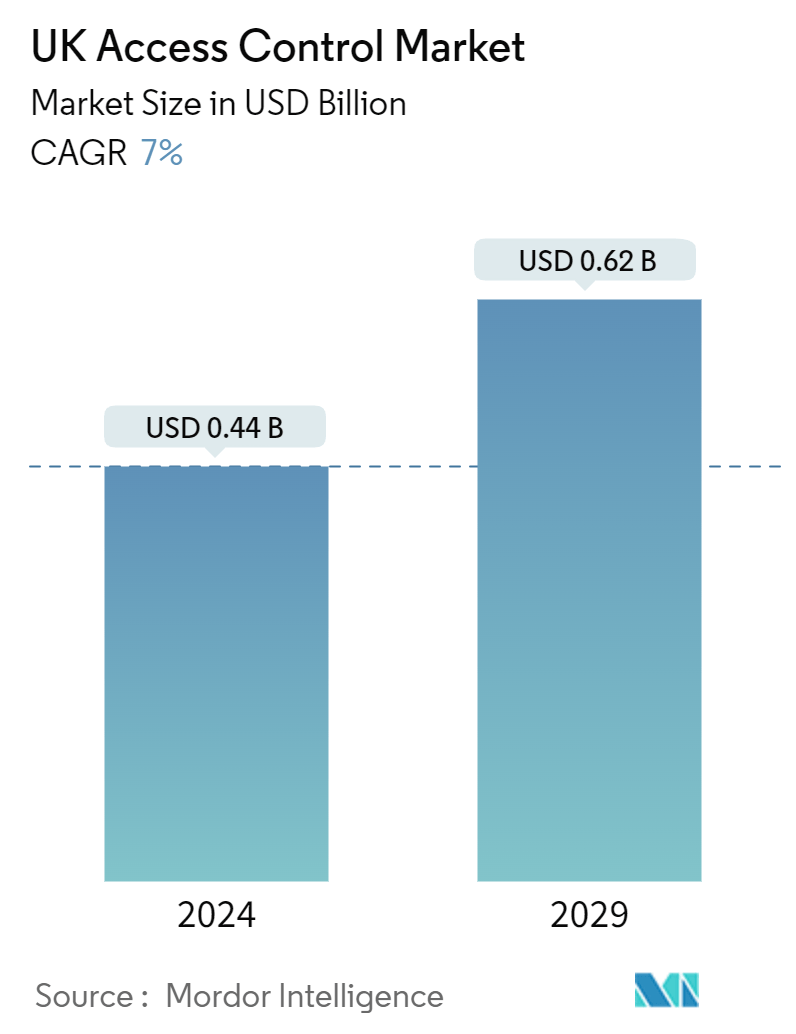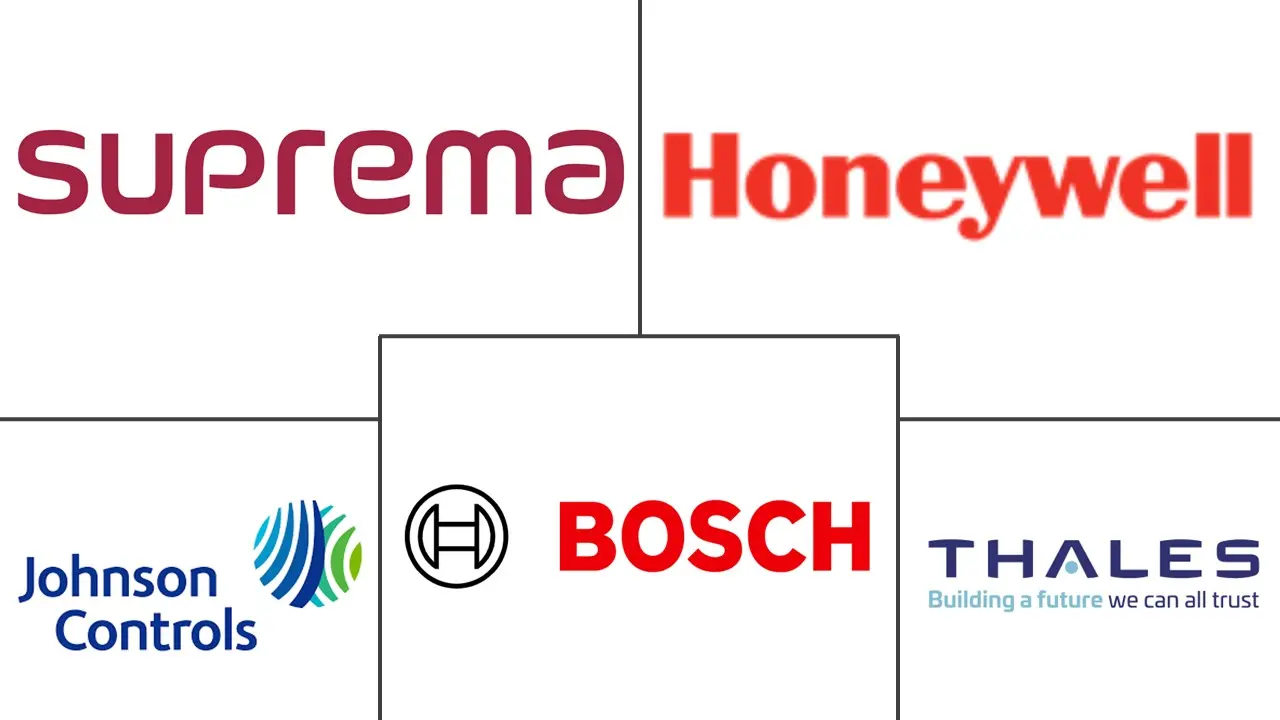Market Size of United Kingdom Access Control Industry

| Study Period | 2019 - 2029 |
| Base Year For Estimation | 2023 |
| Market Size (2024) | USD 0.44 Billion |
| Market Size (2029) | USD 0.62 Billion |
| CAGR (2024 - 2029) | 7.00 % |
| Market Concentration | Low |
Major Players
*Disclaimer: Major Players sorted in no particular order |
United Kingdom Access Control Market Analysis
The UK Access Control Market size is estimated at USD 0.44 billion in 2024, and is expected to reach USD 0.62 billion by 2029, growing at a CAGR of 7% during the forecast period (2024-2029).
- The access control market in the United Kingdom is a critical segment of the broader security industry. Its focus is on protecting physical spaces, assets, and sensitive information from unauthorized access. This market is witnessing significant growth driven by heightened security concerns, regulatory compliance, and rapid technological advancements.
- At the heart of the UK access control market are physical access control systems, which include various hardware such as biometric scanners, card readers, electronic locks, and turnstiles. Biometric systems, which utilize unique biological traits like fingerprints, facial features, and iris patterns, offer high levels of security and are becoming increasingly prevalent. Card readers and keypads, which use RFID technology or require PIN entry, remain popular due to their reliability and ease of integration into existing security frameworks.
- A key driver of the UK access control market is the increasing need for stringent security measures across various commercial, governmental, residential, healthcare, educational, and industrial sectors. Regulatory frameworks such as the General Data Protection Regulation (GDPR) and the UK's Data Protection Act mandate rigorous access control protocols to safeguard personal and sensitive data. Initiatives such as smart cities equipped with technologically advanced infrastructure further fuel the adoption of advanced access control systems.
- Logical access control systems form another critical component of the market, and these systems include user authentication software, identity and access management frameworks, single sign-on solutions, and multifactor authentications. These technologies ensure that only authorized individuals can access sensitive information and digital resources. Cloud-based solutions are gaining traction due to their scalability, flexibility, and remote management capabilities. The integration of these advanced technologies is a defining trend in the UK access control market.
- The UK's commercial construction sector has seen a notable resurgence since 2023, primarily fueled by a surge in high-value development projects, notably in commercial offices. Data from a recent S&P Global survey confirms that this upward trend in construction has persisted into 2024. With these macroeconomic shifts, the demand for access control systems is poised to rise, aligning with the increasing need for new constructions.
- However, like any connected technology, access control systems are vulnerable to cybersecurity threats, such as hacking, malware, and unauthorized access. Additionally, demonstrating the tangible benefits and return on investment of access control systems can be challenging. While these systems enhance security and operational efficiency, quantifying their impact in terms of cost savings or risk mitigation may not always be straightforward.
United Kingdom Access Control Industry Segmentation
The access control market encompasses systems and solutions tailored to govern resource access in computing environments. These technologies and services oversee permissions, authentications, and authorizations, bolstering security and compliance across diverse settings, from physical spaces like buildings and offices to digital realms such as networks and software applications.
The UK access control market is segmented by type (card reader & access control devices [card-based, proximity, smart card], biometric readers, electronic locks, software, and other types) and end-user vertical (commercial, residential, government, industrial, transport & logistics, healthcare, military & defense, and other end-users). The market sizes and forecasts are provided in terms of value (USD) for all the segments.
| By Type | |||||
| |||||
| Biometric Readers | |||||
| Electronic Locks | |||||
| Software | |||||
| Other Types |
| By End User Vertical | |
| Commercial | |
| Residential | |
| Government | |
| Industrial | |
| Transport and Logistics | |
| Healthcare | |
| Military and Defense | |
| Other End User Verticals |
United Kingdom Access Control Market Size Summary
The United Kingdom access control market is a vital component of the broader security industry, focusing on safeguarding physical spaces, assets, and sensitive information from unauthorized access. This market is experiencing robust growth, driven by increasing security concerns, regulatory requirements, and rapid technological advancements. Central to this market are physical access control systems, which encompass hardware such as biometric scanners, card readers, electronic locks, and turnstiles. Biometric systems, utilizing unique biological traits, are gaining popularity due to their high security levels. The market is further propelled by the need for stringent security measures across various sectors, including commercial, governmental, residential, healthcare, educational, and industrial, as well as initiatives like smart cities that demand advanced access control systems.
The commercial sector is the primary driver of the UK access control market, with businesses prioritizing security to protect their assets and ensure safety. The integration of smart building technologies and the Internet of Things (IoT) is encouraging the adoption of advanced access control systems that offer security and operational efficiency. The market is characterized by a fragmented landscape with numerous key players continuously innovating to meet evolving security needs. Biometric readers are witnessing rapid growth, particularly in sectors requiring high security, such as healthcare and finance. The market's expansion is supported by technological advancements, the demand for contactless solutions, and regulatory support, with companies investing heavily in research and development to create sophisticated and user-friendly systems.
United Kingdom Access Control Market Size - Table of Contents
-
1. MARKET INSIGHTS
-
1.1 Market Overview
-
1.2 Industry Attractiveness - Porter's Five Forces Analysis
-
1.2.1 Bargaining Power of Suppliers
-
1.2.2 Bargaining Power of Consumers
-
1.2.3 Threat of New Entrants
-
1.2.4 Threat of Substitute Products
-
1.2.5 Intensity of Competitive Rivalry
-
-
1.3 Industry Value Chain Analysis
-
1.4 Impact of COVID-19 Aftereffects and Other Macroeconomic Factors on the Market
-
-
2. MARKET SEGMENTATION
-
2.1 By Type
-
2.1.1 Card Reader and Access Control Devices
-
2.1.1.1 Card-based
-
2.1.1.2 Proximity
-
2.1.1.3 Smart Card (Contact and Contactless)
-
-
2.1.2 Biometric Readers
-
2.1.3 Electronic Locks
-
2.1.4 Software
-
2.1.5 Other Types
-
-
2.2 By End User Vertical
-
2.2.1 Commercial
-
2.2.2 Residential
-
2.2.3 Government
-
2.2.4 Industrial
-
2.2.5 Transport and Logistics
-
2.2.6 Healthcare
-
2.2.7 Military and Defense
-
2.2.8 Other End User Verticals
-
-
United Kingdom Access Control Market Size FAQs
How big is the United Kingdom Access Control Market?
The United Kingdom Access Control Market size is expected to reach USD 0.44 billion in 2024 and grow at a CAGR of 7% to reach USD 0.62 billion by 2029.
What is the current United Kingdom Access Control Market size?
In 2024, the United Kingdom Access Control Market size is expected to reach USD 0.44 billion.

